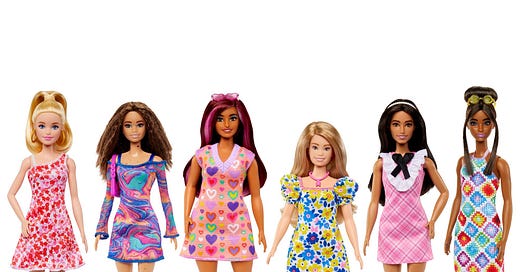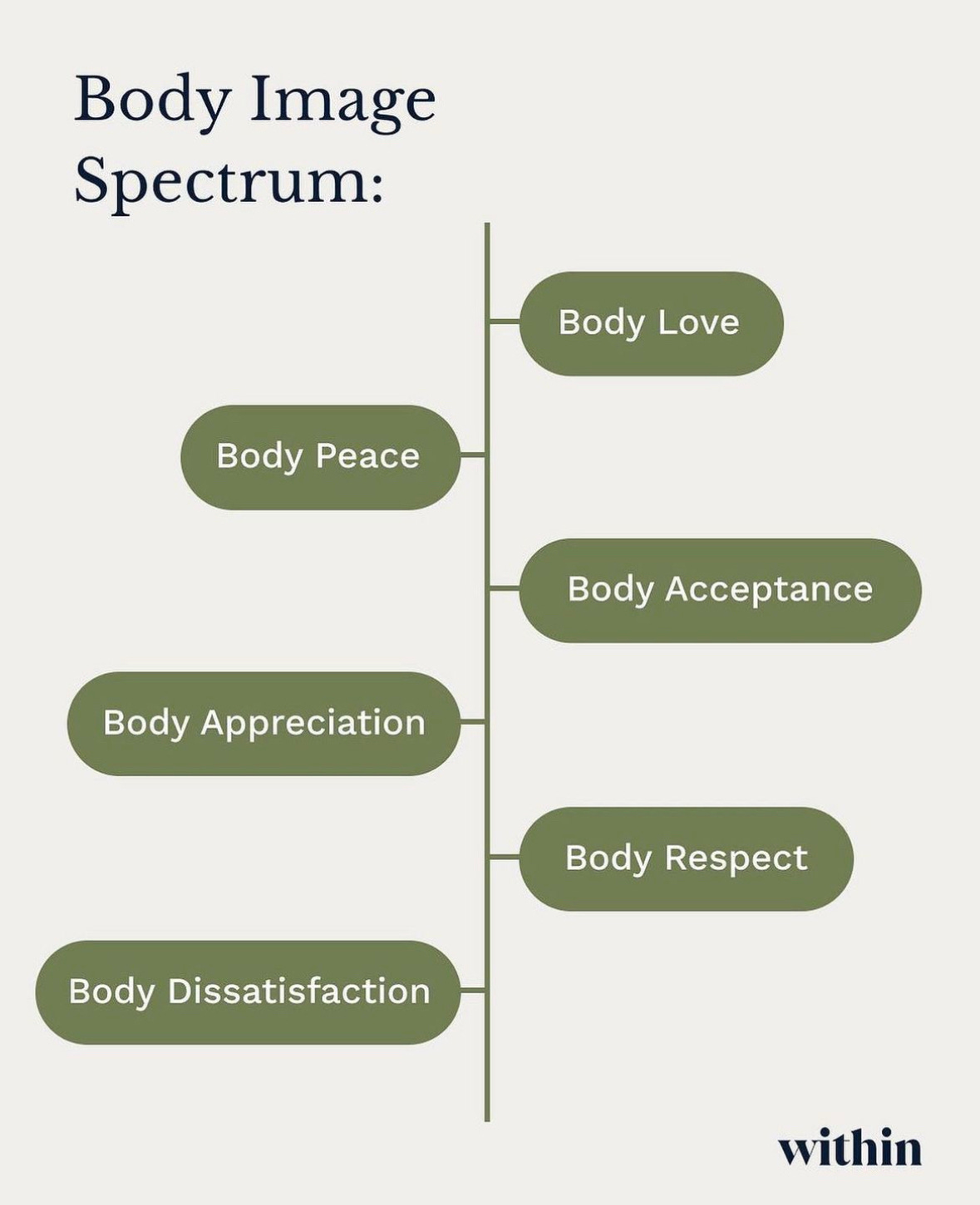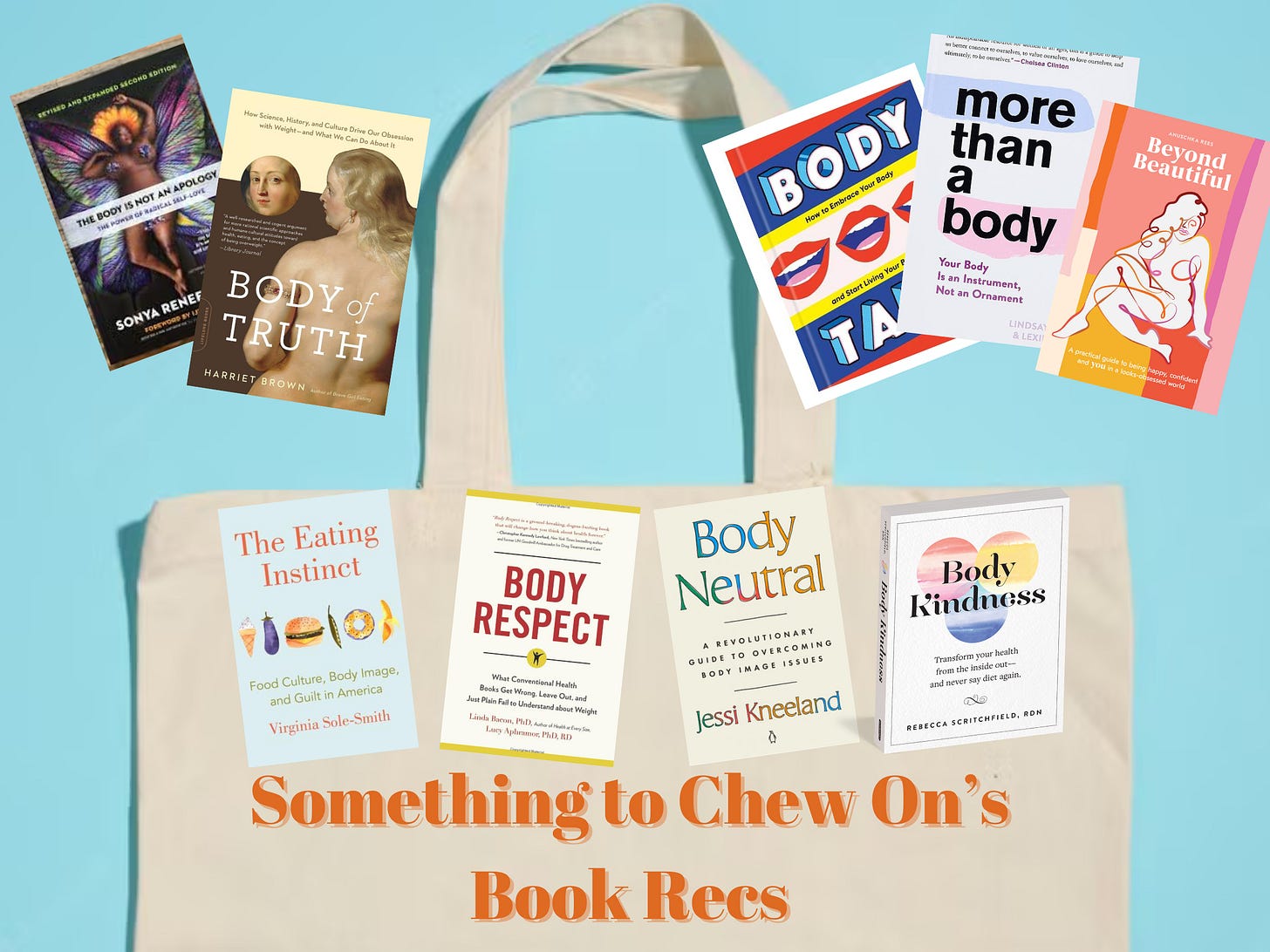HI BARBIE!!!!
*SPOILER ALERT* Thoughts on the new Barbie movie, body image, and some tips to navigate tough body image days...
HI BARBIE!
It’s been a while, hi! In the spur of the moment, I decided to disappear and spend some time with family I hadn’t seen in years and stay present. I also became a Mrs. and had a very special civil ceremony in a room full of so much love, support and joy. All in all, it was a wonderful month but, we’re back baby!
Before my hiatus I had the pleasure of watching Barbie in theaters and haven’t stopped thinking about it. Greta Gerwig did an amazing job at depicting basic feminist ideals, exploring the patriarchy and the nuances of the female experience; bottom line, being a woman is messy and complicated. Margot Robbie’s depiction of Stereotypical Barbie was *chef’s kiss* her looks to her stiff postures, to her acting in general, just perfect. But my favorite part of the movie was America Ferrera’s monologue. Her rant on womanhood had me holding back tears and an urge to stand up and clap!
“You have to be thin, but not too thin. And you can never say you want to be thin. You have to say you want to be healthy, but also you have to be thin…You have to never get old, never be rude, never show off, never be selfish, never fall down, never fail, never show fear, never get out of line. It’s too hard! It’s too contradictory and nobody gives you a medal or says thank you! And it turns out in fact that not only are you doing everything wrong, but also everything is your fault.
I’m just so tired of watching myself and every single other woman tie herself into knots so that people will like us. And if all of that is also true for a doll just representing women, then I don’t even know.”
Though based on a doll, the movie is complex and I could sit here and write multiple essays on it and the fact that it doesn’t have all the answers, but it got me thinking a lot about body image. It’s a complex topic to dive into with many, many layers and history, but I wanted to share some tools and some thoughts.
When Barbie starts changing she notices she has cellulite alongside thoughts of death, she’s becoming more human. In the real world Barbie is faced with objectification and criticism; she is harassed by strangers on the street and bullied by teenage girls.
During her awakening and in an attempt to make Barbieland “perfect” again, Barbie encounters Sasha, the daughter of America Ferrera’s character. Sasha and her friends (who according to the internet are supposed to be Bratz Dolls) tell Barbie how she set unrealistic standards for girls; Barbie taught girls they had to strive to be thin and pretty as they put it. Throughout the years Mattel has released more and more versions of the stereotypical doll; it wasn’t until 2016, less than 10 years ago, that the Barbie Fashionistas line was launched where they claim diversity is embraced through 4 different body types, 7 skin tones, 22 eye colors and 24 hairstyles. It took Mattel 57 years to finally “embrace diversity.” 2020 was a year of greater diversification, with now 35 skin tones, 97 hairstyles and 9 + body types.
Multiple studies have been done in the past on the effects of playing with Barbie dolls and body image. A negative impact has been found in most, however, research shows that results seem to vary generation to generation, likely a reflection of the aforementioned changes at Mattel, with older generations relating the play and use of dolls with greater body dissatisfaction. In most studies, just the picture of Barbie had young women and girls showing a preference for thinner bodies.
But nowadays social media seems to be the bigger threat for pre-adolescent girls and up. The more social media evolves, the more content we have at our fingertips. Exposure to image-related content such as that of Instagram and TikTok vs. text-related such as Facebook may negatively affect body image and lead to greater body dissatisfaction. And with our phones now a permanent accessory we never leave the house without, the use of social media is heightened, and it reaps danger. Body dissatisfaction and negative body image increases the risk of engaging in unhealthy eating practices and disordered eating, especially in adolescents and young adults.
But body image is complex, to say the least. It is the combination of the thoughts, feelings and attitudes that you have about your body, influenced by both internal and external factors. Our beliefs, experiences, and generalizations all contribute to our body image.
Body image relates to:
what a person believes about their appearance
how they feel about their body, height, weight, and shape
how they sense and experience their body
We carry our personal experiences and our familial history and trauma. Marci Evans RD wrote a brilliant post stating “we then have to navigate the larger world via systems, constructs, and cultures which let us know in no uncertain terms whether you are acceptable, welcome, safe, and desirable based on the identities you hold.” She follows to say that as humans our body is our vessel navigating this world, and in the end what we seek is safety and connection.
The issue lies in aspiring to mold and change our body into unrealistic standards believing this will end all our problems and help us reach the safety we yearn for. “Our culture shows us that safety and connection are found in aligning with the norms and standards of our day: thinness, youth, whiteness, strong, able bodies, cisgender presentation, etc.”
But our negative body image and body dissatisfaction has also been said to serve a purpose, it tells us something, and this something usually relates to unmet needs (i.e. safety and connection, etc.) When those intrusive and negative thoughts pop up, it’s wise to take a pause. Put some space between you and the thought to see what’s really the cause of the emotional distress you are experiencing, chances are, it really isn’t about your body…
These thoughts can be seen as “the canary in the coalmine,” as Jessi Kneeland, a body image coach with a body neutrality focus, puts it. These thoughts warn us of greater turmoil. Ultimately, we need to strive to cultivate a sense of self not based on physical appearance and do the internal work to look beyond our body dissatisfaction.
There are some social movements looking to connect and fill the gap in body image work.
Body Positivity: advocates for the acceptance of all bodies, regardless of size, shape, skin tone, gender, or physical abilities.
Pros: Can help create a greater sense of self and body appreciation and lead to greater self-esteem.
Cons: Can lead to the hiding of true feelings. Continues to place the focus on appearance.
Body Neutrality: “middle-of-the-road” movement seeking to prioritize the body’s function and what it can do rather than its appearance. Places no value on appearance.
Pros: Can help you work through the root causes of body image dissatisfaction.
Cons: Can lead to suppressing your true feelings about your body if the effort is set to just “tolerating your body.”
There’s a third piece worth mentioning, body care.
Body Care: the act of taking care of your body regardless of where you are currently on the body image spectrum through proper nourishing and being attentive to your physical, mental, and emotional needs.
These social movements can be great introductions as you strive to work on your relationship with your body. Positive affirmations used in body positivity can help establish body trust, and placing no value on your appearance but appreciating its function such as with body neutrality, can put space between you and your feelings of body dissatisfaction. Using tools to separate your worth from your appearance is a great success compared to loving your appearance all.the.time.
5 Tips for Bad Body Image Days
It takes work; it takes revisiting your history, doing social system work, identifying your triggers, meeting your unmet needs, doing nervous system work, and, well, working through it all. In the meantime here are 5 tips for when days seem heavy and dull, and you’re experiencing a bad body image day.
1. Take care of physical discomfort. What can you do for your here-and-now body? Think of wearing loose clothes, rest if that is what your body needs, avoid foods you know won’t sit well with you, and anything else that means taking care of your body in the moment to you.
2. Tend to your emotional discomfort. As mentioned, it’s most likely not about your body. Take a pause, assess how you are feeling. Try journaling, talking to a friend, or doing some breath work.
3. Make time for self-care. Whatever that looks like-from drinking sufficient water and sticking to your meal plan, to doing a favorite hobby and getting some sunlight. Playing some good music and dancing or going for a walk can also be activities that help ease physical and emotional discomfort.
4. Treat yourself with compassion. Tough love won’t change you or your body; our inner critic is neither wise nor helpful. Be kind to yourself always, but especially on days like this, and acknowledge that this feeling is temporary.
5. Be aware of and avoid body checking behaviors. Avoid standing in front of mirrors and scrutinizing your appearances, weighing yourself, comparing yourself to others. Try to minimize opportunities to blame your body.
If you think affirmations might be a great tool in your toolbox, try having these around or make your own. Write them on post-it notes and put them on your mirror, have them as your screen saver, whatever works for you, for example:
1. My body has carried me through today.
2. I deserve to feel desired.
3. I am more than my appearance.
4. My body has value regardless of its appearance.
5. I love my *insert a part of your body you love*
We spend our whole lives with our bodies, so it is one of, if not the most intimate relationship we have. We might as well try to develop a lovely relationship with it…
Some Resources:
Books:
-The Body is not an Apology by Sonya Renee Taylor
-Body Neutral by Jessi Kneeland
-Body Kindness by Rebecca Scritchfield
-More than a body: Your body is an instrument, not an ornament by Lexie Kite PhD, Lindsay Kite PhD
-Beyond Beautiful by Anuschka Rees
-The Eating Instinct: Food culture, Body Image and Guilt in America by Virginia Sole-Smith
-Body Talk by Katie Sturino
-Body of Truth by Harriet Brown
-Body Respect by Lindo Bacon, PhD
Social Media:
Shira Rose, LCSW: Fat positive + Health At Every Size
Laura Iu RD, CDN, CNSC: Anti-diet dietitian
Michelle Elman: Life coach
Alissa Rumsey MS, RD, CSCS: Weight-inclusive dietitian
Tiffany Ima Akpan: Body confidence coach
Ragen Chastain: Speaker and author of the Weight and Healthcare Substack
Until next time, keep chewin’ and give your body a big hug today!












